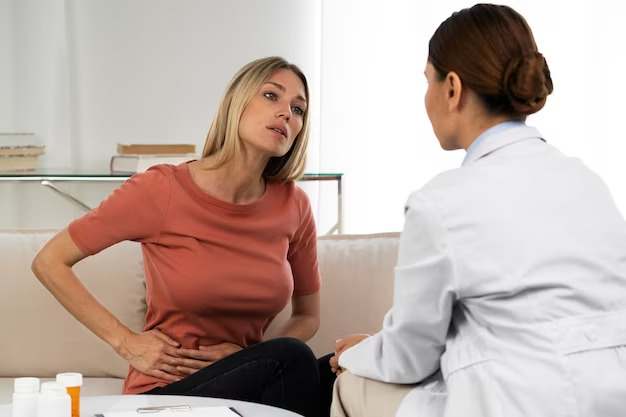Are you cramping after your period? Painful cramping isn’t usually dangerous, but cramps after a period may be a symptom of an underlying condition called secondary dysmenorrhea.
Table of Contents
It results in a problem with your reproductive organs and includes another condition, hence the term secondary. Here are some of those conditions that can cause post-menstrual cramps, according to the Cleveland Clinic.
Endometriosis
Endometriosis is a condition in which the tissue lining the uterus, or endometrial tissue, is found outside the uterus. During your period, these pieces of tissue bleed; this can cause swelling, scarring, and pain. Doctors are unsure of the cause of this.
The Cleveland Clinic says endometriosis is most common in women between 25 and 40 years old, but it can persist after menopause for some.
Other common symptoms include painful sex, difficulty becoming pregnant, abdominal cramps or back pain during menstruation, or painful bowel movements.
Doctors can remove the excess endometrial tissue with surgery. Other medications, like birth control, non-steroidal anti-inflammatory drugs (NSAIDs), or progestins, can be taken to reduce tissue growth and relieve pain.

Adenomyosis
Similar to endometriosis, adenomyosis involves the endometrial tissue. The American College of Obstetricians and Gynecologists explains it as when the endometrial tissue grows into the muscle of the uterus.
As a result, the uterus grows larger than it should and can cause abnormal bleeding and pain. But, again, it’s unknown why women develop adenomyosis.
This condition may affect 20% to 65% of women, but many don’t realize they have the disease because it doesn’t always cause symptoms. It typically occurs in women aged 35 to 50 who have had kids, endometriosis, or uterine fibroids.
Besides post-period cramping, other symptoms are heavy menstrual bleeding, abnormal menstruation, pelvic pain, painful intercourse, infertility, or an enlarged uterus. Common treatments include pain medications, birth control, or a hysterectomy.
Pelvic Inflammatory Disease
Unlike the previous two conditions, pelvic inflammatory disease (PID) is an infection that is treatable with antibiotics. The Mayo Clinic says the infection is caused by bacteria, usually from a sexually transmitted disease (STD), that starts in the uterus and can spread to other reproductive organs.
PID can cause pain in the stomach or pain during sex. It can also cause abnormal vaginal discharge that’s yellow or green with an unusual odor, chills or fever, nausea, and vomiting, a burning sensation when you pee, or irregular periods or spotting.
You are at higher risk for infection if you have an STD, have multiple sexual partners, have had PID in the past, or are sexually active and younger than 25.
Cervical Stenosis
Cervical stenosis is the narrowing of the canal of the cervix, which is the opening of the uterus. It typically results from other conditions such as menopause, cervical or endometrial cancer, surgery involving the cervix, procedures involving the lining of the uterus, or radiation therapy.
Doctors typically only treat women who have symptoms. The treatment plan includes widening the cervix by dilating it with metal rods or using a cervical stent.
Fibroids
Fibroids are benign or noncancerous tumors on the inside or outside the uterine walls. They don’t always cause symptoms, but if they do, they include cramping, heavy menstrual bleeding, back pain, frequent urination, and pain during sex. It is unknown what causes fibroids.
The Cleveland Clinic says about 40% to 80% of women have fibroids, but many don’t experience symptoms. You are more at risk if you are overweight, have a family history of them, have not had children, got your period at a young age, or go through menopause late.
Women’s health providers often discover fibroids during regular pelvic exams. Treatment varies based on the size and location of the fibroid and the symptoms it’s causing.
Standard treatment options include over-the-counter pain medications, iron supplements, birth control, or other oral therapies. Surgery is also an option.

Should I Go to an Urgent Care or ER?
If you are experiencing cramps after a period, or any of the other symptoms mentioned, go to a doctor. You do not have to suffer. There are numerous ways to make period cramping less painful, so schedule an appointment with your doctor.
Urgent Care is a great place to see a doctor if you need immediate relief. Emergency rooms are for life-or limb-threatening health conditions, while urgent care is for those sicknesses that can’t wait for tomorrow but are not as serious that an ER visit is needed. Learn more about the difference between urgent care versus emergency room visits
Walk Into an American Family Care Today!
At American Family Care, we offer walk-in female physical exams. You don’t have to book an appointment; walk in anytime — mornings, evenings, and weekends.
During your visit, you can talk to your doctor about everything from birth control to hormone therapy. So, start feeling better by finding the nearest urgent care location to you.
